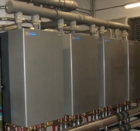Boilers as a reliable way to reducing carbon emissions

When refurbishing, new boilers can provide a reliable means of reducing carbon emissions and savings on energy costs says Bob Walsh.
The mature UK heating market is dominated by a boiler replacement cycle, with many boilers originally installed over 20 years ago. These boilers generally consist of a cast-iron heat exchanger with on/off mode operation, leading to poor seasonal efficiency. Such older boilers have a seasonal efficiency of 70 to 75% (gross) compared to the current minimum standard of 84%, with the norm for modern boilers being greater than 90% (gross).
When you consider the lifetime operating costs of heating installations, the largest element is the cost of the fuel. Over a 15-year cycle, fuel typically accounts for more than 95% of the total outlay on heating plant. Hence, any savings to be gained from the building fabric, controls and boilers will have a direct benefit on the fuel costs and resultant carbon emissions.
In undertaking a refurbishment project, there are many factors to consider if significant savings are to be realised, which may involve all or some of the key areas discussed below.
Improvements to the building fabric will reduce heat losses and, therefore, the capital outlay required for the replacement heating plant. However this may not always be possible.
The implementation of system controls is a must if desired comfort levels are to be achieved and energy savings realised.
Possibilities involve zoning the building to reflect occupancy patterns or the effects of solar gain effects, weather compensation to react to external temperature changes, effective cascade strategies for multiple boiler installations and intelligent optimised time-control strategies to ensure zones are only heated for the duration of occupancy.
The cost of an effective control system is relatively small (less than 5% of the outlay on heating plant) and will deliver tangible benefits.
Heat emitters are quite often overlooked. Normal panel radiators, designed to operate at 80/60°C can deliver sufficient heat whilst operating at the lower temperatures suitable for condensing boilers if improvements to the building fabric have been implemented to reduce heat losses.
Underfloor heating is perfectly suited to condensing boilers, maximising condensing operation at lower flow temperatures. However, their specification can also be influenced by cost and practicality.
Air-handling units and fan coils provide alternative heat emitters but tend to require higher flow temperatures.
If domestic hot water is to be generated, higher flow temperatures will be required to deal with any storage and legionella issues, so it is often more effective to separate the generation of hot water from the heating plant.
Other factors to consider relate to the system design and resulting heating load. The probable full- and part-load demands influence boiler size and required level of turndown, which must be considered, as must the specific requirements of that particular building use, such as a residential care home or school.
Will local factors such as flue discharges and the Clean Air Act influence the installation? Will a building-management system be used to provide the necessary control and interaction with heating system components? And what is the age and condition of the existing heat distribution system (open vented or pressurised)?

Only after considering all the above factors, should the boiler be selected, and it is extremely important to talk with a company that has expert knowledge in heating systems.
At Hamworthy we work closely with our customers, from specification through to installation, with after-sales support in servicing and spares. Our technical sales team can sit down with a specifier and understand every aspect of the project to support optimum product selection, ensuring that the system delivers the output and energy savings required.
Modern compact high-efficiency and condensing boilers offer performance over and above the current and future requirements of the Building Regulations, whereas traditional cast-iron atmospheric boilers will not meet these future requirements. Compliant boilers can interact with building-management systems or be configured into stand-alone systems, with optional accessories providing the desired comfort levels. Premix combustion systems are now the norm and offer modulation levels as low as 20%.
There is a plethora of wall-hung boilers (such as Hamworthy’s Milborne with an output of up to 100 kW) capable of room-sealed operation. Larger-output floor-standing boilers such as Wessex ModuMax or Purewell Variheat, using premix, have sufficient residual fan capacity to drive smaller flues and thus give sufficient flueing flexibility to overcome most installation challenges.
The resultant savings from a well thought out refurbishment project should reduce energy costs and carbon emissions by 20 to 25% and provide the justification for the investment in the project.
At Warwick University, three Wessex ModuMax 120 condensing boilers were installed in the refurbishment of the Avon building and reduced energy consumption by 39% in the first six months.
A later project, the university’s tennis centre, has two Purewell VariHeat 70c condensing boilers and achieved savings of 17 t of CO2 per annum over and above the requirements of Part L. The project also helped the university achieve a B-rated Display Energy Certificate.
Carbon emissions can be reduced even more by the integration of renewable energy with refurbishment projects. Possibilities include biomass boilers, ground- and air-source heat pumps and solar hot water systems.
Bob Walsh is technical director at Hamworthy Heating.








